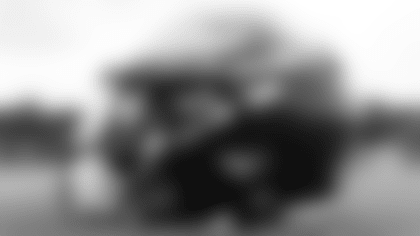The Eagles faced a stiff test last week with Atlanta's young, aggressive defense, but they will see an even tougher unit this Sunday night against Minnesota.
The Vikings have a group that put up historical numbers this year. Look no further than their third-down defense, where they held opponents to a mere 25.2 percent conversion rate. That didn't just lead the NFL this year ... but it was the best number in the league since the famed "Purple People Eaters" of the 1970s. The Vikings have blue-chip talent at all three levels of the field. They don't give up big plays (41 plays allowed of 20-plus yards ranks second in the league), stop the run at a high level (83.4 yards per game ranks second only to the Eagles), and have done a great job of keeping their opponents out of the end zone (their 77.5 percent scoring efficiency in the red zone ranks fourth in the NFL).
Mike Zimmer, the orchestrator of this defense as the head coach, runs one of the most aggressive schemes in the NFL, and it's predicated on pressure. Last year, when these two teams prepared to face off in Week 7, I did a thorough write-up on the staple pressure package for that defense - the Double A-gap front. If you have the time, I encourage you to give that a read because it gives you a deep look the pressure is generated.
For an abridged version, the Vikings like to dictate to the offense. They will put two linebackers over the center and spread the four defensive linemen out, putting six potential pass rushers up on the line of scrimmage against five offensive linemen. This look can only be blocked in one of a couple of ways, and Zimmer knows this. He uses that information to his advantage and attacks the protection.
The Vikings used these looks a TON in 2016, seemingly on every third down. Imagine my surprise when I sat down and studied the unit from this season. Was it still a big part of what the Vikings did? Absolutely. It's still their primary pressure package. But the Vikings used far less of it in 2017. In fact, the Vikings blitzed on 118 pass attempts this season, which ranks 20th in the NFL. The effectiveness of those blitzes, however, is what stands out. Opposing quarterbacks posted a passer rating of 63.56 against the Vikings' blitzes this fall, the lowest number in the league. That is entirely because of Zimmer's schematics paired with the speed they have on that side of the ball.
Before I get into this year's iterations of their Double A-gap pressures, I want to look at some of the other tactics Minnesota uses to attack offenses. Namely, let's look at their overload blitzes and their long stunts up front.
Note that there is audio commentary for each of the video clips.
Shot 1 - The #Vikings still use 'Double A Gap' pressures, but they use a handful of other tactics to get after the QB as well. Excellent blitzing team that can disguise their pressures at a high level. #Eagles have to expect late movement pre-snap on third down #FlyEaglesFly pic.twitter.com/fJqcRaCIgL — Fran Duffy (@fduffy3) January 18, 2018
Minnesota is excellent at disguising its pressures, particularly by showing pressure from one side, forcing the offense to adjust its protection, only to bring the blitz from the opposite side.
Once an offense sets a protection and snaps the ball, the deed is done. There is no coming back and re-adjusting on the fly; it almost never happens.
Watch how the Vikings time up their pressure on the first two plays, waiting for the center to duck his head and prepare to snap the ball. The protections have been set, and that's when the Vikings shift to an overload look. By the time the line tries to adjust, it's far too late, and a free rusher gets home to the quarterback.
The other thing Minnesota will do is use stunts and twists up front to get pressure, something the Eagles have seen a lot of this year. Teams like San Francisco and Seattle were able to get penetration against the Eagles on these types of stunts, so it wouldn't shock me at all if the Vikings made sure to use them on Sunday.
What can the Eagles do to combat these tactics? Well, for the disguise, there are always clues pre-snap that one is coming. Down-and-distance situations certainly help tell a story (the odds that one is coming on third-and-long compared to second-and-short, for instance), and there are usually some tells that a defense has. The quarterback may see the safety cheating hard to one side. Conversely, a receiver may notice a slot corner cheating inside. An offensive lineman may notice that a defensive lineman has his weight back instead of forward. The recognition of these pre-snap tip-offs along with constant communication will be pivotal on Sunday night.
Now let's dive into the Double A-gap looks. This front presents a lot of issues for offenses, especially when you factor in Minnesota's personnel. Eric Kendricks is a savvy blitzer at linebacker while Anthony Barr was viewed by many, including myself, as a pass rusher coming out of UCLA a few years ago. When they line up inside, you have to account for them. You're either calling for a full slide along the offensive line (which would likely result in a running back blocking a defensive end one-on-one) or you're using the back to block one of those linebackers up the middle. The Vikings know you're going to block it up one of those two ways, and they do a lot of things to attack those two potential protections.
Shot 2 - The #Vikings may not use as much of the Double A gap scheme as they did a year ago, but it's still a hallmark of their defense and they do a LOT off of that look. Gives offenses fits with all the combinations of who drops/rushes. It's a lot to prep for as an offense pic.twitter.com/gzvIq2Q72g — Fran Duffy (@fduffy3) January 18, 2018
On the first play against Detroit, Kendricks is matched up one-on-one with the "running back" in the backfield (it's actually tight end Daniel Fells ... which makes me wonder if we will see Trey Burton in a similar role on Sunday). That matchup doesn't happen by accident.
Often, the two linebackers in the A gaps will read the center at the snap. If he opens up to block the linebacker on the left, the defender on the right will blitz. If the center opens up to block the linebacker on the right, the one on the left will go. The center is always wrong, and one rusher will always get into the backfield. That requires the running back to be very decisive and aggressive with his block, stepping up into the pocket and helping maintain the integrity of the pocket to allow the quarterback room to work.
On two of those plays, Zimmer takes advantage of the fact that the running back is occupied in protection. He does this in one of two ways. Either he sends pressure off the edge (typically from safety Harrison Smith), or he uses a stunt with a defensive tackle. Running backs aren't usually great at picking up stunts, particularly when they have to work in tandem with a guard, a player who they're not accustomed to working with in pass pro. This creates advantageous situations for the defense, and it's resulted in some big plays for the Vikings this year.
As I watched more and more of the Vikings and began to realize how little they were actually blitzing this year compared to last year, I saw that they were still getting home. Minnesota will often show pressure before the snap like they're going to blitz, whether it's from an overload look or in a Double A-gap look, and then drop the blitzers into coverage. In that last play in the clip above against Detroit, the Lions protected as if at least one of the A-gap rushers was coming. Smith was even lined up off the edge as if he were blitzing as well. All three defenders dropped. The Lions had six blockers in protection to block just four Vikings, and yet it still resulted in a sack. Had the Vikings just "lined up" in a basic front, that may not have been the case, but the threat of pressure was surely in their heads before the snap of the ball.
Now we get into the Vikings' personnel up front, which I believe is the primary reason why they don't blitz as much now. They don't really need to. Everson Griffen was described by Doug Pederson this week as a "game-wrecker," and I agree. Much like Fletcher Cox for the Eagles, Griffen is a disruptive force up front who can win with both speed and power. With the way they bring pressure, he often ends up one-on-one, and he is VERY tough to block in those situations.
Shot 3 - One of the biggest matchups in this game is Halapoulivaati Vaitai vs Everson Griffen, one of the most disruptive DEs in the NFL. He can win in a number of ways, and the #Vikings scheme allows him to face a lot of one-on-one matchups. Big test for Big V! pic.twitter.com/H5VzzLL2RI — Fran Duffy (@fduffy3) January 18, 2018
Griffen times the snap extremely well and can win off the ball. He has a go-to pass rush move, a quality counter move, and he can win in a lot of different ways off of that. The matchup between him and Halapoulivaati Vaitai will be one of the biggest in this game, without question.
Shot 4 - It's not just Griffen up front, however, because Danielle Hunter and Brian Robison are both very disruptive pass rushers. Robison spends more of his impactful snaps at DT than DE now. Makes for some fun matchups to watch on Sunday night #Eagles #Vikings pic.twitter.com/KPRcDF82t1 — Fran Duffy (@fduffy3) January 18, 2018
It's not just Griffen up front, however, because the Vikings have two other players who are very disruptive pass rushers. Danielle Hunter, the new starter at left defensive end, is a young pass rusher who I liked a lot coming out of LSU a couple of years ago. He's long, has a quick first step, and does a really nice job winning with a speed-to-power rush. He will see most of his reps against Lane Johnson.
Veteran Brian Robison, who was replaced by Hunter in the starting lineup, still sees a lot of quality snaps, particularly inside. Look for him often standing up over a guard and trying to win with his quickness on the interior. It'll be an interesting matchup with him against Stefen Wisniewski and Brandon Brooks on passing downs.
Staying in the trenches, I think the biggest matchup in this game ultimately comes down to the Eagles' run game against the Vikings run defense. Minnesota ranked second in the league this year with just 83.4 yards allowed per game on the ground at just 3.65 yards per carry (fifth in the NFL). They've only allowed 20 runs of 10 or more yards, which is best in the league. The lynchpin inside for them is Linval Joseph. The former New York Giant is a house at nose tackle and dominates the interior for them. You could make the argument that he makes the rest of that defense "go" because of what he's able to do on the inside against multiple blockers on every play. It's not just Joseph though ...
Shot 5 - #Eagles #Vikings on Sunday will be a true heavyweight bout, perhaps nowhere more than in the trenches in the run game. Strength vs Strength. Minnesota is talented across the board, but Eagles have one of the best run schemes in the league. Huge test for both sides pic.twitter.com/cmNHuTKGyB — Fran Duffy (@fduffy3) January 18, 2018
Tom Johnson, who is maybe the lone remaining veteran from NFL Europe still in the league, is a disruptive player inside for them. Both defensive ends, Griffen and Hunter, are strong against the run. The linebackers are aggressive downhill at the point of attack. This is a huge matchup in this game. The Eagles are going to need to run the ball well to stay out of third-and-long situations against a historically good third-down defensive team.
At the end of the day, this is another aggressive, "fast-flow" defense that features a lot of speed. Doug Pederson and his staff put together a masterful game plan against a similar system last week. Eagles fans are hoping he can do the same this Sunday night.
Fran Duffy is the producer of "Eagles Game Plan" which can be seen on Saturdays during the season. Be sure to also check out the "Eagle Eye In The Sky" podcast on the Philadelphia Eagles podcast channel on iTunes. Prior to joining the Eagles in 2011, Duffy was the head video coordinator for the Temple University Football team under former head coach Al Golden. In that role, he spent thousands of hours shooting, logging and assisting with the breakdown of the All-22 film from the team's games, practices and opponents.















